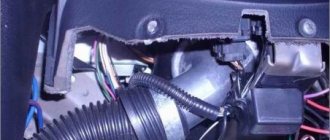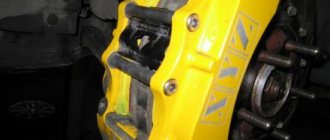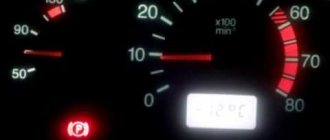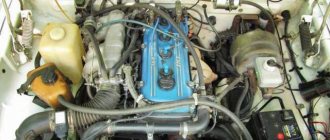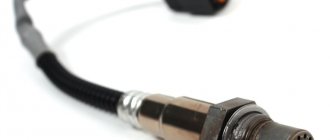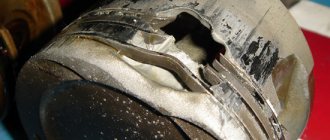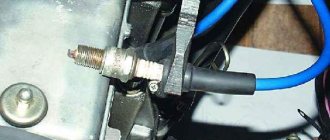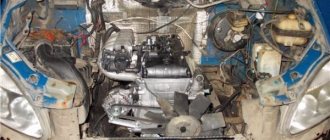03.12.2019
| (Votes: 1, Rating: 5) |
Issues discussed in the material:
- How does the cooling system work in a car?
- For what reasons can antifreeze boil?
- How to deal with antifreeze boiling
A sign of a car breakdown is the constant boiling of liquid in the cooling system of the power unit. This can lead to engine overheating and costly repairs. The cause of such a malfunction may be seemingly minor defects, but if they are not eliminated, the consequences will be very significant. In this article we will take a closer look at why antifreeze boils and look at ways to diagnose such a problem.
Operating principle of the cooling system
To correctly determine why the coolant boils, you need to understand how the engine cooling system works in a modern car.
Operating principle of cooling systems:
- When the engine is cold, the fluid in the system passes through a minimum circle, which includes the water jacket of the power unit, the heater and the thermostat. In this case, its level will be normal.
- When the engine reaches a certain temperature, the thermostat will open a large circle that turns on the main radiator. The heated liquid throughout the circuit will increase in volume, and its excess will begin to flow into the expansion tank. Excessive pressure is relieved by a special valve located in the tank lid.
- When the operating temperature of the power unit reaches 95 ° C, all the antifreeze will flow through the radiator, expanding in volume to the maximum. Excess coolant is discharged through the auxiliary pipe located at the top of the radiator, and the liquid appears to boil.
- As the engine cools, the antifreeze decreases in volume and the pressure decreases. To prevent vacuum, there is a valve in the tank through which air enters from outside.
We recommend
“What kind of antifreeze to pour into a Hyundai: rules for caring for a foreign car” Read more
The cooling systems of many cars have two valves for dumping excess antifreeze into the expansion tank (from the main radiator and the interior heater).
The cap with the valve device in different modifications of the machines can be installed on the tank or on the filler neck of the main radiator. In the second option, excess antifreeze is discharged at certain pressure levels in the system, and outside air enters the expansion tank through a special technological opening.
What not to do when the engine is boiling
There are a number of strict rules that limit the driver’s actions during a situation when antifreeze boils in the radiator, expansion tank or other element of the cooling system. These rules are designed to protect human health from causing serious injury, and to minimize material losses that may arise in the described situation.
- Do not load the engine (do not accelerate, but instead you need to reduce the speed to idle as much as possible, usually around 1000 rpm).
- Do not stop abruptly and turn off the engine, thinking that the engine will stop boiling; on the contrary, everything will only get worse.
- Do not touch hot parts in the engine compartment!
- While steam is coming from under the cap of the expansion tank or other unit and while the antifreeze is bubbling in the system, you should absolutely not open the cap of the expansion tank! This can only be done after the time specified above has passed.
- Do not pour cold water on the engine! You need to wait for the engine to cool down on its own.
- After the engine has cooled down and new antifreeze has been added, you should not drive after the temperature reaches more than +90 degrees.
Compliance with these simple rules will ensure the safety of the driver, and also minimize the degree of breakdown and, consequently, possible material costs.
Why does antifreeze boil in the tank?
Drivers can call boiling of the coolant in a car two processes: its seething or boiling at high temperatures.
The boiling process begins if the temperature of the working medium in the cooling system reaches 115 °C. Why does antifreeze boil in the expansion tank? This could be due to a number of factors:
- jamming of the thermostat damper in the open position leads to constant flow of liquid in a small circle, so it does not have time to cool;
- malfunction of the cooling fan switch sensor;
- the cooling radiator honeycombs are clogged;
- the cooling system is “aired” (an air lock prevents the free flow of antifreeze;
- the water pump is jammed, its shaft is broken or the impeller is destroyed;
- antifreeze has a low density (too diluted with water) and boils already at 100 ° C.
If the antifreeze boils as a result of the factors described above, the engine will overheat and the power unit will fail. At high temperatures, aluminum pistons expand in volume and will leave marks on the inner surface of the steel cylinder liners. If you do not turn off the engine in a timely manner, which has heated up to too high a temperature, you will have to replace the piston group, and possibly the crankshaft.
If the driver sees that the temperature of the engine has exceeded 110 °C, he needs to stop the engine and figure out why the engine is overheating. Major repairs will require large financial investments.
Consequences of boiling antifreeze
Boiling antifreeze always leads to engine overheating. It can be weak, medium and strong. The first occurs if the engine with boiled antifreeze runs for no more than five minutes. As a rule, this does not cause any serious damage. For overheating to be considered moderate, the engine must run with boiling liquid for approximately 10–15 minutes. At the same time, it is already characterized by the following problems:
- leaks in the main radiator;
- rupture of cooling system hoses and leakage of hot fluid;
- shrinkage of piston rings, due to which oil consumption increases;
- seal seal failure and oil leakage.
Why does antifreeze boil in the expansion tank, and how does it manifest itself?
The fact that the coolant boils in the reservoir at operating temperatures in the range of 90–95 ° C can be considered normal if there are no leaks from the system or other signs of malfunction.
When antifreeze thermally expands, its excess volume is dumped into the reservoir. An inexperienced car enthusiast may mistake the resulting seething for boiling.
We recommend
“Reasons for antifreeze failure: how to recognize a malfunction” Read more
An increase in the temperature of the antifreeze poses a threat to the power unit. If the gauge on the dashboard shows a normal value, the engine will not overheat.
It should be noted that the bubbling of antifreeze may not always be harmless. If this process is observed when the engine is cold and is accompanied by other signs of malfunction, the cooling system should be diagnosed. Next, we will consider the most common symptoms of a malfunction.
Coolant boils 2-5 minutes after you turn off the engine, indicating a breakdown of the valve that is built into the radiator cap. Since this element is constantly open, the antifreeze moves into the expansion tank through the pipe located at the top.
The boiling of antifreeze and the presence of drips on the body of the container indicate a jammed valve of the tank lid. In this case, steam from the system escapes through a leaky thread or may even explode the expansion tank.
Abundant white exhaust smoke and the presence of drips on the expansion tank are symptoms that the cylinder block gasket is broken. In this case, gases under high pressure, which are created by the pistons, enter the antifreeze, and it boils.
If a gasket defect allows engine oil to enter the cooling system, an emulsion will form in the expansion tank (it is “whipped” by the water pump).
A blown cylinder head gasket is a serious problem that should be addressed as quickly as possible. Malfunctions of the expansion tank cap and bypass valves are not so critical, but they lead to antifreeze leakage, which will ultimately lead to overheating of the engine (a sign of such malfunctions can be the frequent turning on of the cooling fan). It is necessary to determine exactly why the antifreeze is boiling in the radiator.
How to relieve stress and nervous tension without drugs: 20 ways to calm your nerves
The modern rhythm of life often makes a person feel stressed. Stress gives us life and it also takes it away. To be healthy, you need to get rid of unnecessary worries in time.
How to relieve nervous tension and stress? What can a person do for himself to worry and worry less?
In this article, you will learn about ways to help you relax and prevent a stressful situation.
How to fix the problem
If the coolant boils in the expansion tank and the engine temperature rises to more than 110 °C, turn off the engine and diagnose the malfunction using the following algorithm:
- Check with your hand how hot the bottom of the radiator is. If it does not heat up when the antifreeze boils, it means the thermostat is faulty. You need to wait until the engine cools down and ensure that the car is delivered to a car service center to replace the part (the thermostat is not repaired).
- If the main radiator fan does not work, you will need a diagnosis from an experienced auto electrician.
- The version with clogged cells is checked last, but to do this you need to disassemble the system and remove the radiator.
- If the pump jams or breaks, a sharp temperature rise occurs while the engine is running and antifreeze leaks through the pump seal. It is impossible to continue driving in such a car. The pump needs to be replaced urgently.
- Signs of thermostat failure can be confused with symptoms that appear if an air lock forms in the cooling system. It should be taken into account that “airing” of the system can occur if the system is not filled correctly with coolant.
- To remove air from the cooling system, you need to remove the pipe at the top point (as a rule, it is located in the area of the throttle valve block) and add antifreeze until it begins to flow out of the removed hose.
We recommend
“How to drain the antifreeze completely and fill the system with new one: useful recommendations” Read more
How to deal with malfunctioning expansion tank caps or the main radiator? It is better to change these parts immediately, since after repair they do not last very long. At the same time, you should pay attention to the condition of the plastic housing of the expansion tank (cracks may appear on it as a result of increased pressure). It is not advisable to use the car after the cooling system bypass valve is stuck.
Replacement of a broken gasket between the hydraulic unit and the cylinder block must be carried out urgently. Antifreeze mixed with oil can cause serious damage to the engine. As a result of such a breakdown, a water hammer may occur and the walls of the combustion chamber on a diesel engine will collapse. The main sign of a broken gasket is white exhaust smoke. To avoid serious damage, you need to monitor changes in the color and consistency of the antifreeze in the expansion tank.
The thermostat will have to be replaced if, when the engine warms up, the lower radiator hose and the main radiator are cold. This situation indicates that the valve of this element does not open to the required amount, so the antifreeze circulates only in a small circle and does not enter the radiator.
The fan cooling the main radiator turns on when the coolant reaches a preset temperature. If this does not happen, then the antifreeze boils. The electric fan motor breaks down very rarely. Most often, to eliminate a malfunction, you need to check its contacts.
A malfunction of the temperature sensor leads to the fact that at the right time the signal to turn on the electric fan motor is not received. This sensor must be replaced.
If the antifreeze boils after replacing it, then there is a possibility that its quality does not meet the required standards. Normal coolant boils when the temperature in the system rises to +108 °C +110 °C. Poor quality antifreeze may have a lower boiling point.
If antifreeze boils in your car while on the road, you should check the operation of the cooling system according to the algorithm presented above. You should not drive your car to a car service center if the water pump is broken, there are defects in the cylinder head gasket and there is a complete lack of coolant in the system. In other situations, you can drive to the repair site yourself, paying attention to the temperature of the engine and making periodic stops to cool it. If the antifreeze level is insufficient, distilled water can be added to the system.
Why is boiling dangerous?
Boiling of the coolant indicates either poor quality or insufficient level of the mixture, or serious problems in the cooling system. They can provoke a number of unpleasant consequences, including those dangerous for the normal operation of the car:
- overheating of engine elements or cooling system, resulting in their failure;
- disappearance of antifreeze from the tank: it can completely boil away, resulting in incorrect operation of the entire system.
Car repairs can be a significant expense. If you don’t figure out the reason for the antifreeze boiling off, you will need to constantly purchase new fluid, and in case of overheating, a quick breakdown is almost inevitable. So, if you find that the fluid in the expansion tank is gurgling in an atypical manner and its level is decreasing, try to take action as soon as possible.
Why antifreeze boils: from the experience of car owners
- Most often, the problem is in the radiator “If the thermostat is stuck in the small circle position in hot weather, engine overheating will be visible by the position of the arrow on the instrument panel. If it jams on a large circle, then in the summer it will be almost unnoticeable (except that the engine will take longer to warm up to operating temperature). If the radiator cap valve holds pressure, its cells are clogged, or exhaust gases enter the cooling system, it’s worth checking the simplest thing - whether the radiator is visible.”
- Haste is good only when catching fleas
“If the antifreeze boils on an unheated engine, most likely the cylinder head gasket has failed and needs to be replaced. You can, of course, look at the expansion valve cover valve. Maybe it's stuck or broken. Then you need to check the antifreeze level and the presence of an air lock in the system. When pouring coolant, it is worth checking whether the pressure pipes have blown off. To do this, you can use distilled water so as not to waste expensive antifreeze. If everything is in order with the system, you can fill in antifreeze.” - The pump was replaced and the order
was “I ran into a problem: the machine with water in the cooling system worked normally (the fan turned on at 92 °C), but when I filled it with antifreeze, it began to boil. I flushed the system again and filled it with distilled water - everything was back to normal. After a long study, the problem was found. It turned out that due to the higher lubricating properties of antifreeze, the impeller of the water pump was slipping. It was experimentally established that when heated, water flows normally from the discharge holes, and antifreeze barely oozes out (with further heating of the engine, the flow of coolant stopped altogether). Replacing the water pump fixed the system." - Needs to be cleaned and washed
“The reason why antifreeze boils may be internal and external contamination of the radiator. Dirt collects between the radiators of the air conditioner and the engine. The outside of the radiator should be washed with a Karcher and the fluid in the system should be replaced.If the thermostat is stuck, then the liquid flows in the minimum circle (cooling jacket and heater).
The main radiator cap should be free of rust and the valve should be in good working order. When heated, the antifreeze increases in volume and fills the expansion barrel. When the fluid cools, the check valve helps it “suck” into the radiator to its full level.”
We recommend
“How often to change antifreeze: increasing engine life” Read more
- Blame the traffic jam
“I recently encountered an interesting situation. I was driving along the highway with the air conditioner on, and suddenly the temperature gauge crept up. I turned off the air conditioner and the temperature dropped. But when I started driving up the hill, I saw that the car was boiling. I stopped, opened the hood and looked at the radiator cap: the valve had simply come off and fallen off. I drove fifteen hundred kilometers, constantly adding water, and couldn’t buy a cap anywhere. It turns out that without it the engine boils, even despite the fact that the viscous coupling was installed and the radiator fan was constantly spinning. Later I found the plug during disassembly, installed it, and the problem went away!”
What to do if antifreeze boils
What to do if the engine boils
However, the most interesting and interesting question for drivers is the following - what to do if antifreeze/antifreeze boils on the road or in a parking lot. The first thing to remember is not to panic, that is, to keep the situation under control! It is advisable to draw attention to the fact that the cooling system has partially failed as soon as possible. This can be done either using instruments on the panel or visually by looking at the steam coming out from under the hood. The sooner you take appropriate action, the greater the likelihood of getting away with inexpensive repairs.
There is a simple algorithm that every car enthusiast should know, even those who have never encountered a similar situation. It consists of the following steps:
- Switch to neutral speed and reduce engine speed to idle.
- Continue driving and do not suddenly slow down. The oncoming air will blow the engine as much as possible to cool it.
- While still driving turn on the interior heater to the highest possible temperature. Moreover, this must be done regardless of the time of year, that is, if necessary, even in the summer heat. This procedure is done in order to remove heat from the radiator as much as possible so that it cools down as much as possible at no-load speed.
- You need to roll for as long as possible, until it comes to a complete stop (if this happens in the summer, then it is advisable to find a stopping place somewhere in the shade , without direct sunlight). Afterwards the engine must be turned off. In this case, the ignition must be left on in order to allow the stove to work for another 5…10 minutes . After this, turn off the ignition.
- Open the hood in order to give maximum access to natural air into the engine compartment. Without touching any engine parts with your hands (now they are at an extremely high temperature), wait a certain time . In summer it is about 40...50 minutes, in winter - about 20. Depends on weather conditions and the time the car was “boiling”.
- Call a tow truck or a car that will tow the car to a service station or to a good mechanic with the appropriate diagnostic equipment.
Dirty radiator - If there are no cars nearby, then after the mentioned time, making sure that there is no more boiling and the liquid has “calmed down,” carefully unscrew the cap of the expansion tank of the cooling system and add clean water . If you are traveling close, you can use some non-carbonated drinks. Fill to the mark.
- Start the car, turn on the heater to maximum and continue driving at low speeds. As soon as the coolant temperature reaches +90°C, you need to stop and wait again for about 40 minutes . If you're not far away, you're in luck. Otherwise, you need to look for an option with a tow truck or tug.
- Upon arrival at the service station, tell the technicians about the problem; usually they can easily find the breakdown (among those described above) and fix it.
- Also be sure to ask them to change the antifreeze , since the liquid that is currently in the system has already lost its performance properties.
- Carry out a breakdown diagnosis in order to find the cause of the boiling and eliminate it so that the situation does not recur in the future.
The algorithm of actions is simple, and even an inexperienced driver can cope with it. The main thing is to notice the process of antifreeze boiling in time. And it is advisable to always have a small supply of coolant (similar or compatible with that currently used) in the trunk, as well as engine oil. The canister does not take up much space, and can come in handy at a critical moment.
Boiling point of antifreeze and antifreeze of different classes
Antifreeze is a substance used as a coolant in the cooling system of vehicles. However, many car owners, out of habit, call antifreeze antifreeze. The latter is a brand of antifreeze. It began to be produced back in Soviet times, and there was no alternative to this product at that time. Antifreeze and antifreeze differ in composition:
- antifreeze contains water and ethylene glycol, as well as additives based on salts of inorganic acids;
- antifreeze also includes ethylene glycol or propylene glycol, water and additives. The latter are used on the basis of organic salts and improve the anti-foam and anti-corrosion properties of the coolant.
Antifreeze comes in different classes, each characterized by its own color marking:
- G11 - blue or green, or blue-green;
- G12 (both with and without pluses) – red with all shades: from orange to lilac;
- G13 - purple or pink, but theoretically they can be any color.
Antifreeze varies by class, color and characteristics
The main difference between classes of antifreeze is the different bases and characteristics of the liquids. If previously water was poured into the car cooling system, which boiled at +100 °C, then the use of the type of coolant in question made it possible to increase this value:
- blue and green antifreezes have approximately the same boiling points - +109–115 °C. The difference between them is the freezing point. For green antifreeze it is about -25 °C, and for blue antifreeze it is from -40 to -50 °C;
- red antifreeze has a boiling point of +105–125 °C. Thanks to the additives used, the likelihood of it boiling is reduced to zero;
- G13 class antifreeze boils at a temperature of +108–114 °C.
The consequences of boiling antifreeze
If the coolant boils for a short time, nothing bad will happen to the engine. However, if you continue to operate the machine with the problem for more than 15 minutes, the following consequences are possible:
- damage to the cooling system pipes;
- leakage in the main radiator;
- increased wear of piston rings;
- The lip seals will cease to perform their functions, which will lead to the release of lubricant to the outside.
Antifreeze may boil due to coolant leaking from the system
If you drive a car with boiling antifreeze for a long time, more serious damage is possible:
- destruction of valve seats;
- damage to the cylinder head gasket;
- destruction of the partitions between the rings on the pistons;
- valve failure;
- damage to the cylinder head and the piston elements themselves.
Video: consequences of engine overheating
Daewoo Nexia Nexuses TAX › Logbook › Nexia 150 Help boiled
1.6 engine boiled, the temperature rose, hobbled to the garage, filled the throat with antifreeze, pressed on the pipe, antifreeze went through the plug - I thought it was a plug, replaced it. I revved it up, opened the lid, touched the pipes, they were all hot, they were all squeezing.
I drove it for 2 hours, the temperature rose again, under the hood, antifreeze and air were leaking through the lid.
under-inflated? or khan for something.
the fan is working, the pipes are hot, the stove is not blowing very hotly as before, but not warm either.
How to choose a good antifreeze
It can be quite difficult to determine from the color and smell of a liquid whether it is good or poor quality. It is recommended not to experiment and choose brands of antifreeze that are suitable for your car model, or universal options, such as multifreeze. You need to buy a cooler only in trusted places, so as not to be afraid of encountering a low-quality fake. A properly selected fluid in a car whose systems have no malfunctions will not boil or lead to overheating or breakdown of components. The main thing is to pay attention to the compatibility tables, do not mix incompatible types and use only proven brands. SINTEC Multifreeze, compatible with all types of machines and suitable for almost all operating conditions, is a good choice.

